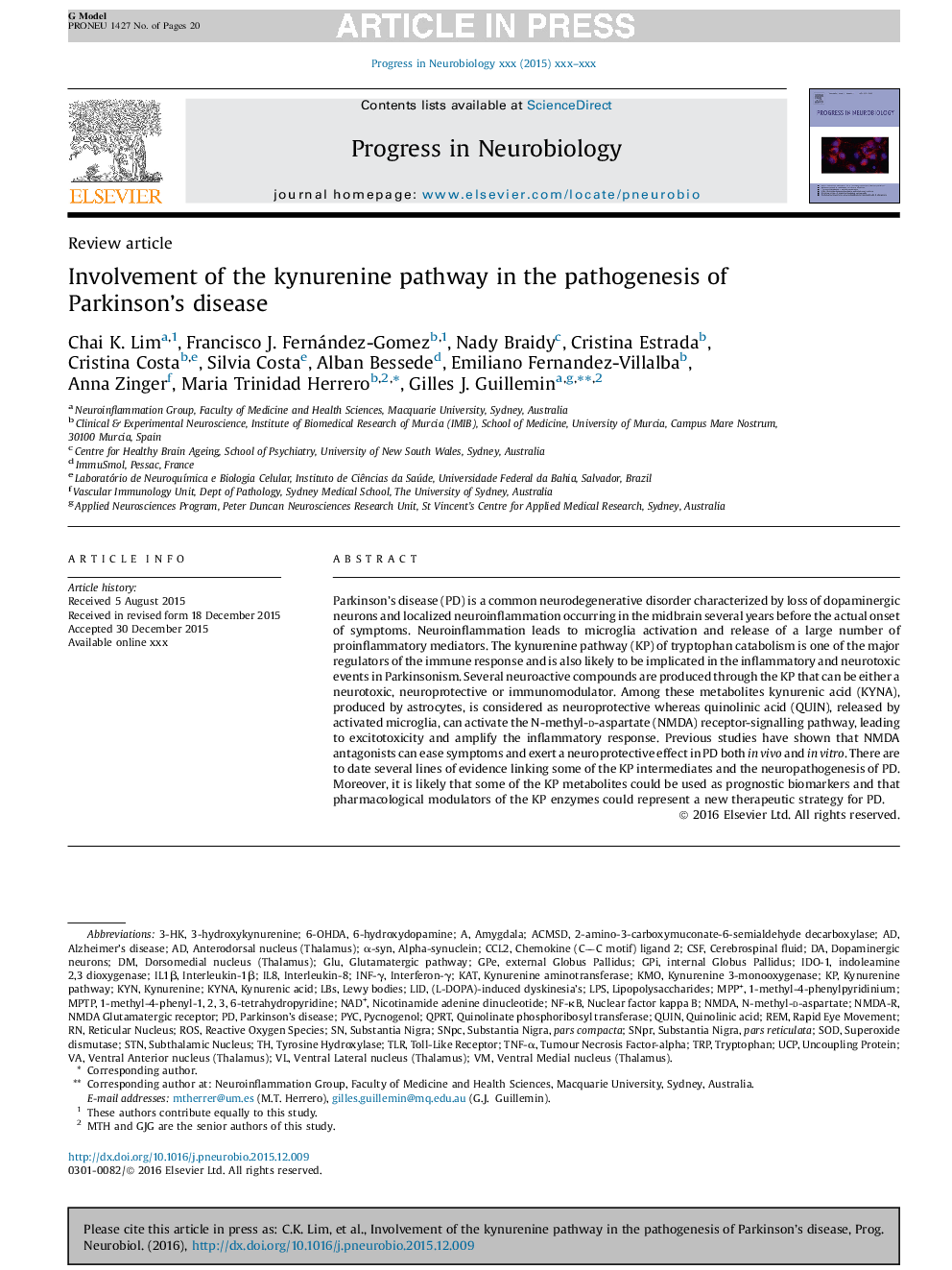| کد مقاله | کد نشریه | سال انتشار | مقاله انگلیسی | نسخه تمام متن |
|---|---|---|---|---|
| 5739163 | 1615360 | 2017 | 20 صفحه PDF | دانلود رایگان |
عنوان انگلیسی مقاله ISI
Involvement of the kynurenine pathway in the pathogenesis of Parkinson's disease
ترجمه فارسی عنوان
مشارکت مسیر کینورناین در پاتوژنز بیماری پارکینسون
دانلود مقاله + سفارش ترجمه
دانلود مقاله ISI انگلیسی
رایگان برای ایرانیان
کلمات کلیدی
NMDAGPEUCPKynurenine 3-monooxygenaseLBSα-SynINF-γ3-HKMPTPIL8N-methyl-d-aspartateREMSTNQUINTLR1-methyl-4-phenylpyridiniumGPiNMDA-RPyCCCL2IDO-1TrpLPS6-OHDAQPRTNF-κBchemokine (CC motif) ligand 2LIDACMSD1-methyl-4-phenyl-1, 2, 3, 6-tetrahydropyridine6-Hydroxydopamine3-hydroxykynurenine - 3-هیدروکسی ...external globus pallidus - globus pallidus خارجیinternal globus pallidus - globus pallidus داخلیIL1β - IL1bMPP+ - MPP +NAD+ - NAD +ROS - ROSKMO - SMESNpc - SNPCSNpr - SNPRSubstantia Nigra, pars reticulata - Substantia Nigra، pars reticulataAlpha-synuclein - آلفا سینوئولینAmygdala - آمیگدال، بادامهkynurenic acid - اسید کینورنیکQuinolinic acid - اسید کینولینیکinterferon-γ - اینترفرون-γInterleukin-8 - اینترلوکین -8Interleukin-1β - اینترلوکین-1βIndoleamine 2,3 dioxygenase - ایندولامین 2،3 دی اکسیژنازLewy bodies - بدن لویAlzheimer’s disease - بیماری آلزایمرParkinsońs disease - بیماری پارکینسونTryptophan - تریپتوفانsubstantia nigra - توده سیاهsubstantia nigra, pars compacta - توده سیاه، پارس متراکمtumour necrosis factor-alpha - تومور نکروز عامل آلفاtyrosine hydroxylase - تیروزین هیدروکسیلازToll-like receptor - تیالآرKYN - جنسیتrapid eye movement - حرکت سریع چشمSOD - سدSuperoxide dismutase - سوکسوکس دیسموتازTNF-α - فاکتور نکروز توموری آلفاnuclear factor kappa B - فاکتور هسته ای کاپا BLipopolysaccharides - لیپوپلی ساکارید هاCSF - مایع مغزی نخاعیCerebrospinal fluid - مایع مغزی نخاعیkynurenine pathway - مسیر kynurenineDopaminergic neurons - نورونهای دوپامینرژیکNAD, nicotinamide adenine dinucleotide - نیکوتینامید آدنین دینوکلئوتیدReticular nucleus - هسته ReticularSubthalamic nucleus - هسته ی زیرهالامیکUncoupling protein - پروتئین جدا کردنPycnogenol - پیکنوژنولKAT - کتKYNA - کیاناkynurenine - کینورینینKynurenine aminotransferase - کینورینین آمینوترانسفرازGlu - گلوReactive oxygen species - گونههای فعال اکسیژن
موضوعات مرتبط
علوم زیستی و بیوفناوری
علم عصب شناسی
علوم اعصاب (عمومی)
چکیده انگلیسی
Parkinson's disease (PD) is a common neurodegenerative disorder characterized by loss of dopaminergic neurons and localized neuroinflammation occurring in the midbrain several years before the actual onset of symptoms. Neuroinflammation leads to microglia activation and release of a large number of proinflammatory mediators. The kynurenine pathway (KP) of tryptophan catabolism is one of the major regulators of the immune response and is also likely to be implicated in the inflammatory and neurotoxic events in Parkinsonism. Several neuroactive compounds are produced through the KP that can be either a neurotoxic, neuroprotective or immunomodulator. Among these metabolites kynurenic acid (KYNA), produced by astrocytes, is considered as neuroprotective whereas quinolinic acid (QUIN), released by activated microglia, can activate the N-methyl-d-aspartate (NMDA) receptor-signalling pathway, leading to excitotoxicity and amplify the inflammatory response. Previous studies have shown that NMDA antagonists can ease symptoms and exert a neuroprotective effect in PD both in vivo and in vitro. There are to date several lines of evidence linking some of the KP intermediates and the neuropathogenesis of PD. Moreover, it is likely that some of the KP metabolites could be used as prognostic biomarkers and that pharmacological modulators of the KP enzymes could represent a new therapeutic strategy for PD.
ناشر
Database: Elsevier - ScienceDirect (ساینس دایرکت)
Journal: Progress in Neurobiology - Volume 155, August 2017, Pages 76-95
Journal: Progress in Neurobiology - Volume 155, August 2017, Pages 76-95
نویسندگان
Chai K. Lim, Francisco J. Fernández-Gomez, Nady Braidy, Cristina Estrada, Cristina Costa, Silvia Costa, Alban Bessede, Emiliano Fernandez-Villalba, Anna Zinger, Maria Trinidad Herrero, Gilles J. Guillemin,
